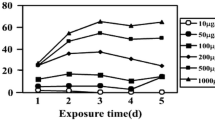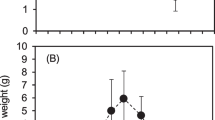Summary
The symbiotic heterocystous cyanobacteriumAnabaena azollae present in the leaf cavities of the water fernAzolla spp. was studied. The cyanobacteria extracted from the leaf cavities showed differences in pigment composition in three species ofAzolla, i.e A.pinnata var.pinnata, A.caroliniana and A.filiculoides, as observed by pigment absorption and epifluorescence tests. These differences suggest that of these species the cyanobiont ofA. pinnata is the most actively nitrogenfixing form. This has been confirmed by nitrogen fixation (acetylene reduction) tests. Heterocysts of the symbiont ofA. pinnata were characterized by high chlorophylla and low phycocyanin content, a low fluorescence yield of chlorophyll in the heterocysts compared to vegetative cells and a gradient of phycocyanin concentration in the vegetative cells adjacent to heterocysts. This indicates that only photosystem I is present in the heterocyst. In the two otherAzolla species quantitative shifts in the pigment composition occurred suggesting a lower nitrogen fixation activity.
In the cyanobiontAnabaena azollae the heterocyst frequency could reach a value of 44–45%. It is argued that there are two generations of heterocysts in a matureAzolla plant, which are concomitant with two peaks of nitrogen fixation activity correlated with leaf age,i.e. leaf number along the main axis of the plant. At both peaks of maximal N2-ase activity, only 20–25% of the heterocysts present are metabolically active as demonstrated by the reduction of Neotetrazolium chloride (NTC) in the heterocysts and darkening of nuclear emulsions by silver salt reduction. Vegetative cells of the cyanobiont reduce Neotetrazolium chloride (NTC) to formazan more rapidly than has been observed in the free-living heterocystous cyanobacteriumAnabaena cylindrica tested in parallel experiments. This feature may be due to a more permeable cell wall of the vegetative cells of the cyanobiont compared to the free-living form, since the vegetative cells of the symbiont play a role in cross-feeding of the host (Azolla).
Evidence is obtained that only the heterocysts of the cyanobiont ofAzolla are involved in the nitrogen fixation process as in free-living heterocystous cyanobacterium species. This situation is different from other cyanobacterial symbioses such as inGunnera, Blasia andAnthoceros, where physiological modifications are reported in the symbiosis with another photosynthetic partner such as the absence of O2 evolution and the absence of photo-fixation of CO2 in the cyanobionts.
Pigment composition and N2-ase activity in the symbiotic cyanobacteria of three Azolla species have indicated the superiority of theA. pinnata symbiont.A. pinnata var.pinnata is a semidomesticated form used in S.E. Asia for agricultural purposes (irrigated rice culture) to increase soil fertility.
It is suggested that by selection (domestication) more efficient strains (clones) can be obtained, and further that with more advanced techniques such as gene mutation and genetic manipulation even more efficient and for agriculture more beneficial clones can be obtained.
Similar content being viewed by others
References
Allen, M. B. and Aron, D. I. 1955 Studies on nitrogen-fixing blue-green algae. I. Growth and nitrogen fixation byAnabaena cylindrica Lemm. Plant Physiol. Lancaster30, 366–372.
Becking, J. H. 1972 Ecological-hydrobiological study on irrigated rice fields in relation of the fixation of atmospheric nitrogen. Report Netherlands Foundation for the Advancement of Tropical Research (WOTRO), The Hague, The Netherlands 42 p.
Becking, J. H. 1975 Nitrogen fixation in some natural ecosystems in Indonesia.In Symbiotic Nitrogen Fixation in Plants. IBP Synthesis meeting, Edinburg, Sept. 1973, vol. 7, pp 539–550, Ed. P.S. Nutman. Cambridge Univ. Press, Cambridge, England.
Becking, J. H. 1976 Contribution of Plant-Algal Associations.In Proc. 1st. Intern. Symposium of Nitrogen Fixation, Pullman, Washington, U.S., June 1974, vol.2, pp 556–580, Eds. W. E. Newton and C. J. Nyman. Washington State Univ. Press, Pullman, U.S.
Becking, J. H. 1978 Ecology and physiological adaptations of Anabaena in the Azolla-Anabaena azollae symbiosis.In Environmental role of Nitrogen-fixing Blue-green Algae and Asymbiotic Bacteria, Symposium Uppsala, Sweden, Sept. 1976. Ecol. Bull. (Stockholm)26, 266–281.
Becking, J. H. 1979 Environmental requirements of Azolla for use in tropical rice production. Symposium Intern. Rice Res. Institute, Los Baños, Philippines, Sept. 1978.In Nitrogen and Rice, pp 345–373, Intern. Rice Research Institute, Manila, Philippines.
Donze, M. 1973 Pigment Systems in Algae. Electron Transport to Nitrogenase in Anabaena. PH. D. Thesis, State University Leiden, Leiden, The Netherlands 86 p.
Donze, M., Haveman, J. and Schiereck, P. 1972 Absence of photosystem 2 in heterocysts of the blue-green alga Anabaena. Biochim. Biophys. Acta256, 157–161.
Fay, P. and Kulasooriya, W. A. 1972 Tetrazolium reduction and nitrogenase activity in heterocystous blue-green algae. Arch. Mikrobiol.87, 341–352.
Fay, P., Stewart, W. D. P., Walsby, A. E. and Fogg, G. E. 1968 Is the heterocyst the site of nitrogen fixation in blue-green algae. Nature London220, 810–812.
Gorkom, H. J. van and Donze, M. 1971 Localization of nitrogen fixation in Anabaena. Nature London234, 231–232.
Haselkorn, R. 1978 Heterocysts. Annu. Rev. Plant Physiol.29, 319–344.
Hewitt, E. J. 1966 Sand and Water Culture Methods used in the study of Plant Nutrition. Techn. Commun. No.22 (Revised), Commonw. Bur. Hortic. Plant. Crops East Malling, Maidstone, Kent, England, 2nd ed. 547 p.
Oes, A. 1913 Über die Assimilation des freien Stickstoffs durch Azolla. Z. Bot.5, 145–163.
Peters, G. A. and Mayne, B. C. 1974 TheAzolla-Anabaena azollae relationship. I. Initial characterization of the association. Plant Physiol. Lancaster53, 813–819.
Rodgers, G. A. and Stewart, W. D. P. 1977 The Cyanophyte-Hepatic symbiosis I. Morphology and Physiology. New Phytol.78, 441–458.
Silvester, W. B. 1975 Endophyte adaptation inGunnera-Nostoc symbiosis.In Symbiotic Nitrogen Fixation in Plants, IBP Synthesis meeting, Edinburgh Scotl. 1973, vol.7, pp 521–538, Ed. P. S. Nutman. Cambridge Univ. Press. Cambridge, England.
Stewart, W. D. P. 1980 Systems involving Blue-green Algae (Cyanobacteria).In Methods for Evaluating Biological Nitrogen Fixation. pp 583–635, Ed. F. J. Bergersen. John Wiley & Sons Ltd., New York.
Stewart, W. D. P., Haystead, A. and Pearson, H. W. 1969 Nitrogenase activity in heterocysts of blue-green algae. Nature London224, 226–228.
Strasburger, E. 1873 ÜberAzolla. 86 p. +Tafel I–VII, Herman Dabis Verlag, Jena.
Thomas, J. 1970 Absence of the pigments of photosystem II of photosynthesis in heterocysts of a blue-green alga. Nature London228, 181–182.
Author information
Authors and Affiliations
Rights and permissions
About this article
Cite this article
Becking, J.H., Donze, M. Pigment distribution and nitrogen fixation inAnabaena azollae . Plant Soil 61, 203–226 (1981). https://doi.org/10.1007/BF02277375
Received:
Issue Date:
DOI: https://doi.org/10.1007/BF02277375




